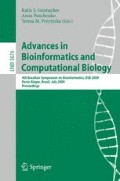Abstract
Human Immunodeficiency Type-1 subtype C (HIV-1C) is rapidly diverging among populations causing more than 48% of infections worldwide. HIV-1C gp120’s 128 sequences available at Genbank were aligned and submitted to phylogenetic analysis. Three major clusters were identified: 72 sequences aligned with a Brazilian 0072eference sequence; 44 sequences aligned with an Ethiopian sequence and 12 could be group along with Indian isolates. A search was made for conserved HIV-1C cytotoxic T lymphocyte (CTL) epitopes to A*0201, A*0301, A*1101 e B*07 human leukocyte antigen (HLA) alleles (using Epijen software). Five most conserved epitopes were recognized: QMHEDIISL, CTHGIKPVV, NLTNNVKTI, AITQACPKV, CTRPNNNTR. Our results showed a recognized evolutionary force of HIV-1 to escape from CTL responses mutating sites that can be negatively select by host’s immune system. The present study brings up a new approach to in silico epitope analysis taking into account geographical informations on virus diversity and host genetic background.
Access this chapter
Tax calculation will be finalised at checkout
Purchases are for personal use only
Preview
Unable to display preview. Download preview PDF.
References
McMichael, A.J., Rowland-Jones, S.L.: Cellular Immune Responses to HIV. Nature 410, 980–987 (2001)
Novitsky, V.A., Montano, M.A., McLane, M.F., et al.: Molecular cloning and phylogenetic analysis of human immunodeficiency virus type I subtype C: a set of 23 full-length clones from Botswana. J. Virol. 73, 4427–4432 (1999)
Russell, K.L., Carcamo, C., Watts, D.M., et al.: Emerging genetic diversity of HIV-1 in South America. AIDS 14, 1785–1791 (2000)
Bello, G., Passaes, C.P., Guimaraes, M.L., Lorete, R.S., et al.: Origin and evolutionary history of HIV-1 subtype C in Brazil. AIDS 22, 1993–2000 (2008)
WHO-UNAIDS Report from a meeting Vaccine Advisory Comitee Geneva. Approaches to the development of broadly protective HIV vaccines: challenges posed by the genetic, biological and antigenic variability of HIV-1. AIDS 15, W1–W25 (2001)
De Groot, A.S., Jesdale, B., Martin, W., et al.: Mapping cross-clade HIV-1 vaccine epitopes using a bioinformatics approach. Vaccine 21, 4486–4504 (2003)
Oliveira, T., Deforche, K., Cassol, S., et al.: An Automated Genotyping System for Analysis of HIV-1 and other Microbial Sequences. Bioinfomatics 21(19), 3797–3800 (2005)
Rhee, S.Y., Gonzales, M.J., Kantor, R., et al.: Human immunodeficiency virus reverse transcriptase and protease sequence database. Nucleic Acids Res. 31, 298–303 (2003)
Thompson, J.D., Gibson, T.J., Plewniak, F., et al.: The ClustalX windows interface: flexible strategies for multiple sequence alignment aided by quality analysis tools. Nucleic Acids Res. 24, 4876–4882 (1997)
Hall, T.A.: BioEdit: a user-friendly biological sequence alignment editor and analysis program for Windows 95/98/NT. In: Nucl. Acids Symp. Ser., vol. 41, pp. 95–98 (1999)
Swofford, D.L.: PAUP*: phylogenetic analysis using parsimony (*and other methods) Sinauer Associates, Sunderland, Mass. (2001)
Doytchinova, I.A., Guan, P., Flower, D.R.: EpiJen: a server for multi-step T cell epitope prediction. BMC Bioinformatics 7, 131 (2006)
Sette, A., Sidney, J.: Nine major HLA class I supertypes account for the vast preponderance of HLA-A and -B polymorphism. Immunogenetics 50, 201–212 (1999)
Kesmir, C., Nussbaum, A., Schild, H., Detours, V., Brunak, S.: Prediction of proteasome cleavage motifs by neural networks. Prot. Eng. 15(4), 287–296 (2002)
Shankar, P., Fabry, J.A., Fong, D.M., et al.: Three regions of HIV-1 gp160 contain clusters of immunodominant CTL epitopes. Immunol. Lett. 52, 23–30 (1996)
Author information
Authors and Affiliations
Editor information
Editors and Affiliations
Rights and permissions
Copyright information
© 2009 Springer-Verlag Berlin Heidelberg
About this paper
Cite this paper
Junqueira, D.M., de Medeiros, R.M., de Matos Almeida, S.E., Paixão-Cortez, V.R., Roehe, P.M., Spilki, F.R. (2009). Mapping HIV-1 Subtype C gp120Epitopes Using a Bioinformatic Approach. In: Guimarães, K.S., Panchenko, A., Przytycka, T.M. (eds) Advances in Bioinformatics and Computational Biology. BSB 2009. Lecture Notes in Computer Science(), vol 5676. Springer, Berlin, Heidelberg. https://doi.org/10.1007/978-3-642-03223-3_16
Download citation
DOI: https://doi.org/10.1007/978-3-642-03223-3_16
Publisher Name: Springer, Berlin, Heidelberg
Print ISBN: 978-3-642-03222-6
Online ISBN: 978-3-642-03223-3
eBook Packages: Computer ScienceComputer Science (R0)

